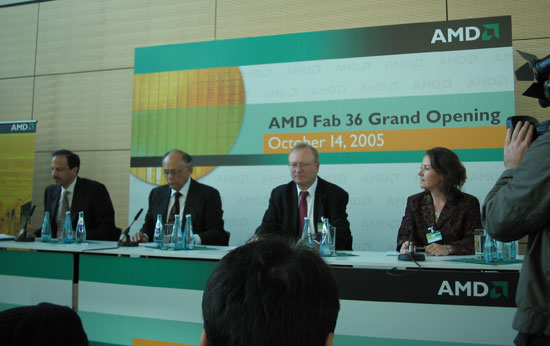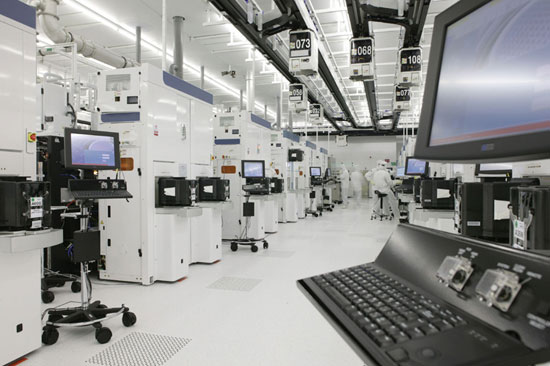An AMD Update: Fab 36 Begins Shipments, Planning for 65nm and AM2 Performance
by Anand Lal Shimpi on April 4, 2006 11:00 AM EST- Posted in
- CPUs
A little under 6 months ago AMD introduced their first 300mm 90nm manufacturing facility, called Fab 36. The name of course comes from its existence 36 years after the founding of AMD, with the plant itself being located next to Fab 30 in Dresden, Germany.
The grand opening of Fab 36 was mostly for media attention as the plant would not begin shipping revenue parts until Q1 of 2006. That sometime is today as AMD has just announced that Fab 36 is finally shipping revenue parts. The parts that it is shipping are 90nm Athlon 64 and Sempron CPUs, so Opterons and Athlon 64 X2s will still come out of Fab 30 next door. AMD cites customer demand as the reason that Athlon 64 and Sempron are first out of the new fab, which honestly makes sense; there's always need for more capacity at the lower end.

Although both Fab 30 and Fab 36 produce 90nm processors, Fab 30 uses smaller 200mm wafers while Fab 36 features an upgrade to 300mm wafers. AMD says that yields on 300mm wafers coming out of Fab 36 are comparable to 200mm yields being produced at Fab 30.

In terms of capacity, by 2008 AMD plans to be able to crank out 20,000 (300mm) wafers per month out of Fab 36 which would double its microprocessor production capacity to approximately 100M CPUs per year (thanks to larger wafers and smaller transistors). For comparison, Fab 30 currently produces 30,000 (200mm) wafers per month. Unfortunately AMD was unable to provide us with any sort of guidance as to how quickly Fab 36 will ramp up to its 20K per month target. AMD's partnership with Chartered Semiconductor Manufacturing Ltd. out of Singapore will guarantee additional 90nm production capacity beginning in the second half of this year. By the end of this year, AMD's capacity will have increased tremendously over the single fab they had producing 90nm parts previously.
As we mentioned in our initial coverage of Fab 36's grand opening, all parts shipping out of the plant will be 90nm, with AMD converting to 65nm starting in the second half of this year. Fab 36 will be "substantially converted" to 65nm manufacturing by the middle of 2007. Once again, AMD wasn't able to provide us with any sort of concrete details about the ramp to 65nm. It could very well be that AMD will be shipping lots of revenue generating 65nm parts by the end of this year, or they could be shipping very little. If the latter is true, then AMD's real transition to 65nm won't occur until far into 2007. When it does happen however, the move to 65nm will bring about smaller die sizes, faster switching transistors and lower power consumption for AMD, just as it has for Intel. AMD's 65nm process will incorporate their third generation of SOI technology to further reduce power consumption. AMD is promising a 40% increase in transistor performance with the move to 65nm thanks to the smaller process and the third generation SOI technology.

Fab 36 in Action










68 Comments
View All Comments
coldpower27 - Wednesday, April 5, 2006 - link
Yeah considering AMD has gotten only 15% so far from 90nm DSL SOI, considering they make 3.00GHZ of ocurse.BaronMatrix - Tuesday, April 4, 2006 - link
Intel showed NO INCREASE WHEN GOING TO DDR2, so how is AMD slacking if they DON'T get 10-20% increase?defter - Wednesday, April 5, 2006 - link
Because Intel's chips were FSB limited and couldn't take advantage of full bandwidth that DDR2 offered. AMD's chip can utilize full bandwidth because of integrated memory controller.creathir - Tuesday, April 4, 2006 - link
Horray! He lives! At least AM2 is finally starting to look more like a "next gen" platform than it has in the past.- Creathir
ncage - Tuesday, April 4, 2006 - link
Isn't ibm helping them out some in this department?bob661 - Tuesday, April 4, 2006 - link
Good to see them working on 45nm. Hopefully, the next transition will be closer together with Intel. Competition is good.Furen - Tuesday, April 4, 2006 - link
The problem is that the actual transition to a new manufacturing process requires a pretty hefty investment. I'm sure AMD has been able to go 65nm for a while now, it just cant afford to do so.mesyn191 - Wednesday, April 5, 2006 - link
No, they've been waiting on tools from other manufacturers + validating thier VHDL libraries. In fact that is why FAB36 is starting out with .90 production instead of .65, AMD wants to get some revenue from it ASAP and since thier .65 stuff is still on order they have to work with what they've got instead.